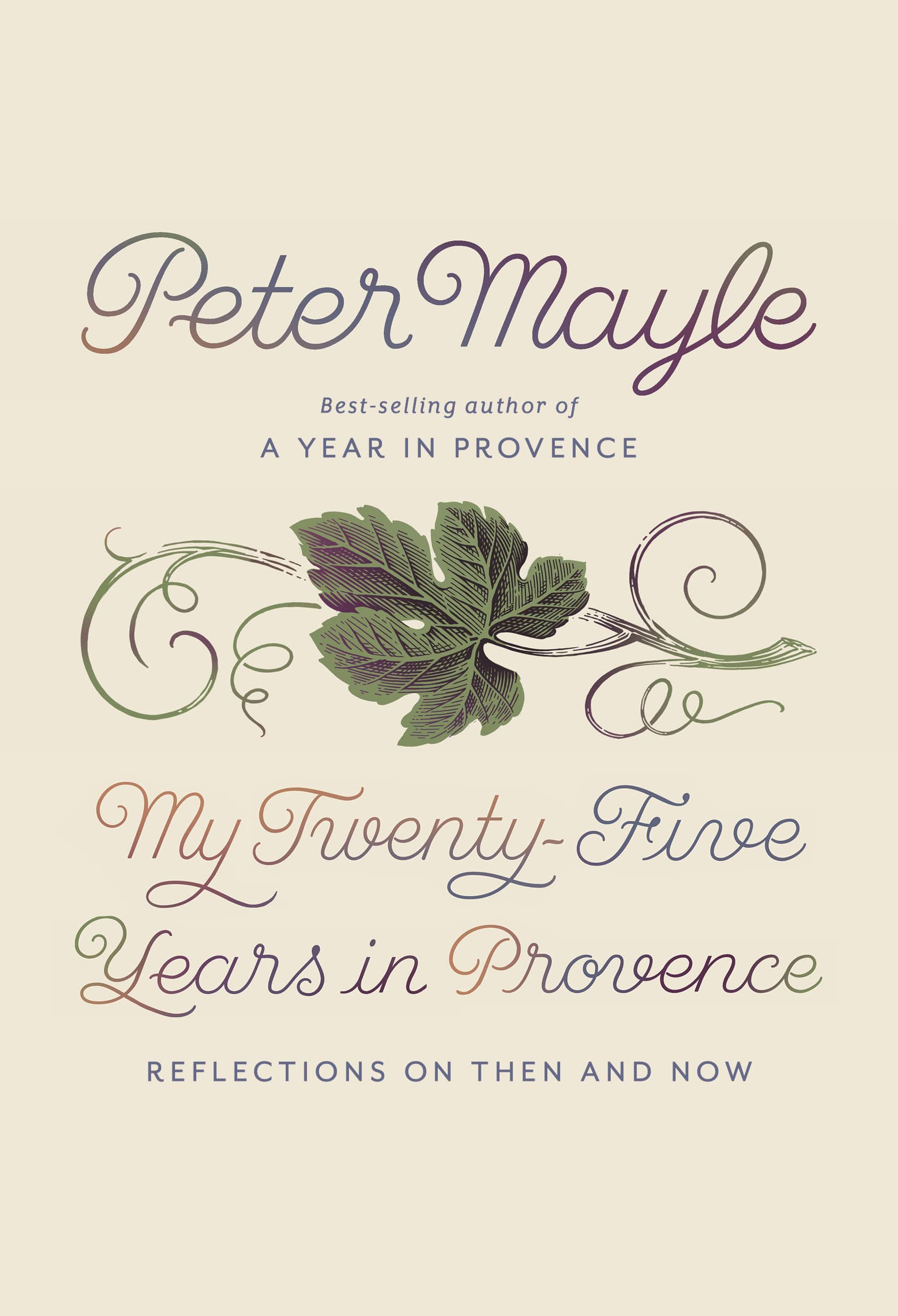My Twenty-Five Years in Provence: Reflections on Then and Now
23.00 JOD
Please allow 2 – 5 weeks for delivery of this item
Description
The beloved author Peter Mayle, champion of all things Provence, here in a final volume of all-new writing, offers vivid recollections from his twenty-five years in the South of France: lessons learned, culinary delights enjoyed, and changes observed.Twenty-five years ago, Peter Mayle and his wife, Jennie, were rained out of a planned two weeks on the Côte d’Azur. In search of sunlight, they set off for Aix-en-Provence; enchanted by the world and life they found there, they soon decided to uproot their lives in England and settle in Provence. They have never looked back. As Mayle tells us, a cup of café might now cost three euros–but that price still buys you a front-row seat to the charming and indelible parade of village life. After the coffee, you might drive to see a lavender field that has bloomed every year for centuries, or stroll through the ancient history that coexists alongside Marseille’s metropolitan bustle. Modern life may have seeped into sleepy Provence, but its magic remains.With his signature warmth, wit, and humor–and twenty-five years of experience–Peter Mayle is a one-of-a-kind guide to the continuing appeal of Provence. This thoughtful, vivid exploration of life well-lived, à la Provence, will charm longtime fans and a new generation of readers alike.
Additional information
| Weight | 0.3 kg |
|---|---|
| Dimensions | 2.04 × 13.47 × 20.07 cm |
| PubliCanadanadation City/Country | Canada |
| by | |
| format | |
| Language | |
| Pages | 192 |
| publisher | |
| Year Published | 2018-6-26 |
| Imprint | |
| ISBN 10 | 0525609954 |
| About The Author | PETER MAYLE is the author of fifteen previous books. A recipient of the Légion d'Honneur from the French government for his cultural contributions, he lived in Provence with his wife, Jennie, for more than twenty-five years. He died in January 2018. |
“Full of thoughtful reflections and trenchant observations . . . it all adds up to a better understanding of the people and culture of Provence. Mayle is astute at capturing the rhythm of life there.” —Regan McMahon, San Francisco Chronicle“A warm, nostalgia-soaked look at the place [Mayle] loved so dearly, packed with fond recollections of the pleasures of life in the region, from pastis to Pétanque . . . An ideal summertime read.” —Lila Battis, Travel and Leisure“This 25-year retrospective serves up the cozy cafes, refreshing rosés and joie de vivre that drew many people in Mayle’s footsteps to the sun-washed Luberon region . . . [a] well-loved writer’s contented recap of a life well lived.” —Maureen McCarthy, Minneapolis Star-Tribune “Endearing . . . Short and sweet, these stories paint an idyllic picture of a charming, slow-paced place, the sort that might beckon for the next season of life. And with Mayle's memories, tips and powerful storytelling, you'll realize it's possible, whichever destination you pick.” —Ashley Day, USA Today“Treads delightfully familiar ground for fans who succumbed to the charms of Mayle’s first book" —Beth J. Harpaz, Associated Press“A bittersweet pleasure . . . While Mayle can pen a mouthwatering description of bouillabaisse, what has always drawn his readers to his writing are his loving portraits of people, community and the Provençal way of life.” —Carla Jean Whitley, BookPage“This valedictory memoir will hold special appeal to devoted readers of his Provencal adventures as well as those in search of confirmation that daydreams do come true.” —Library Journal“[Mayle’s] keen eye and wit are much on display in this all-new collection of writings on his times in the south of France.” —The Philadelphia Inquirer"Fans of Mayle (who died in January) will be delighted by this final book from Provence’s most impassioned booster. . . . Composed in a uniformly bright and jocular voice, this is a breezy valedictory note for a much admired writer." –Publishers Weekly |
|
| Excerpt From Book | A Midsummer Night’s Treat For most of the week, it’s nothing special, an old coopérative fruitière, where local producers used to sell what they had produced. A large area originally used for parking trucks and tractors, bordered by L-shape stone buildings, it’s a good example of the kind of light-industrial architecture often found in rural parts of Provence—practical, no frills, and, until recently, no people. Now, thanks to a forward-looking mayor and some high-tech enthusiasts, it has become an IT center known as La Fruitière Numérique. Each Tuesday evening between May and October, technology gives way to gastronomy in the form of a marché nocturne, an evening market with a difference. It has the great advantage of being just across the road from the center of Lourmarin, one of the prettiest and most popular villages in the Luberon. This in itself is enough to guarantee a good turnout. Tourists and residents alike, having spent a tough day in the sun, can find shade and relief from the heat, enough wine to provide relief from thirst, a generous choice of fresh produce, and an introduction to some of the finer points of professional cuisine. These are offered by a different local chef each week, often assisted by the mayor of Lourmarin, who acts as master of ceremonies, introducing the chef and his chosen subject. There are nine of these kitchen heroes, who take a break from their restaurants to demonstrate some of the tricks of their trade. One week it might be the secrets of a perfect pasta, made with local cherry tomatoes, local olives, and local olive oil. The next week could feature a sublime strawberry dessert. The menu is long, varied, fascinating, and simple. The audience, sitting on wooden benches, is rapt. Before the turn of the chef, the market starts to become busy and, in high summer, the setting for an informal fashion show, featuring an abundance of cooked flesh. Among the ladies, shorts seem to get shorter and dresses more diaphanous every week, and the display of hats is enough to make a milliner swoon. Recently I saw, among the sea of Panamas, a vintage trilby, a couple of turbans, and what I imagine was an Australian sombrero, with one side of the brim pinned up in the style of a bush hat. The dress code for men varies. At one end of the style spectrum, there is the occasional aging hippie, with gray ponytail (they’ve become increasingly popular), silver bracelets, and tattoos. At the other end are the Parisians with their sartorial guard down—suits replaced by well-pressed shorts, polo shirts, and suede moccasins, all spotless. They mingle in a swirl of relaxed humanity, with no visible pushing and shoving, and this politesse helps to create an unusually good-humored atmosphere. I have rarely seen such a well-behaved crowd, and they all seem to be enjoying themselves. If you get to the market early enough, around six, you can not only choose your spot, but furnish it. Tin tables of various sizes have been placed well away from the food stalls, and there are plenty of folding chairs. But never quite enough, because there are always more bottoms than seats. With organized couples, this frequently leads to a division of responsibilities. The husband occupies the table, lays claim to two chairs, and guards the bottle of wine and two glasses while his wife goes short-distance shopping around the stalls, coming back to the table from time to time to have a quick sip and drop off provisions before returning to the stalls to carry on with her noble task. She is spoiled for choice, but there are a couple of horrors she won’t find. First, there is no trace of shrink wrap, bubble wrap, or any other form of plastic supermarket packaging: the growers like you to see what you’re going to eat without any artificial trimmings. They are proud of what they’ve grown, whether it’s fat white asparagus, fragrant peaches, or bouquets of chard. The sell-by date is this evening, just a few hours after the produce has been picked. The second welcome absence is that dangerous vehicle, the supermarket cart. There is no risk of suffering a glancing blow or squashed feet after being run over by a cart whose pilot is too busy consulting her cell phone to look where she’s going. The only shopping aid on wheels I’ve seen was what appeared to be an oversized, mechanized roller skate, driven by a German gentleman. The front and back wheels were joined by a short platform on which the driver stood. Steering was by a set of waist-high handlebars, and power came from a tiny noiseless engine. I watched as this ingenious contraption glided silently through the crowd and stopped at two or three stalls before returning to the driver’s table with bulging shopping bags dangling from the handlebars. This was repeated several times, totally accident-free. For those of us on foot, a tour of the stalls can take a very pleasant half hour, often more. Sausage lovers can find several varieties to nibble on. There are cheeses soft and hard, quiches large and small, and a selection of home-baked treats that varies from week to week. There are jams, and there are olive oils. The produce is displayed on tray upon tray, fruits and vegetables and herbs, all of it just picked; some, like the deep purple eggplant, are polished to a high level of gloss. Nothing contains preservatives, artificial colorings, or additives of any kind. In other words, nature has been left alone. Browsing through the garlic is, as you can imagine, thirsty work, but the market organizers have come to the rescue: there’s a bar. Small and simple it may be, but it is extremely well stocked with wine of all colors, on sale by the glass or, for advanced cases of dehydration, by the bottle. It was at the bar that we saw something I’m sure could only happen in France. A young girl, maybe nine years old, barely the height of the bar counter, waited patiently until her turn came. With impressive self-assurance, she ordered two glasses of Muscat, and slid a ten-euro note across to the barman, who brought her the wine. I assume that he thought she was just another customer, although shorter than most. At no time did he ask who the wine was for. I can’t imagine this kind of nonchalance in an English pub or an American bar, where the very idea of an underage person getting anywhere near alcohol is cause for consternation and alarm. The barman, of course, knew that the girl was being a good and dutiful daughter, taking the wine to her parents. Around seven thirty, the market begins to look like a sprawling self-service café. Most of the shopping has been done, and it’s time for further refreshment—wine, of course, with a slice or two of cheese, sausage, or whatever else has just been bought from the stalls. The mood is cheerful, the heat of the day has given way to a pleasantly cool evening, and nobody is in a rush to leave. Indeed, nobody is in a rush to do anything except enjoy the moment, and it is often nine thirty or so before the last customers are gone, some of them having eaten everything they have just bought. Never mind. There’s always next Tuesday. The whole evening has been a pleasure rather than a chore. If there is a more civilized way to go food shopping, I have yet to find it. And you will never need a can opener to help you enjoy the food you’ve chosen. |
Only logged in customers who have purchased this product may leave a review.






Reviews
There are no reviews yet.